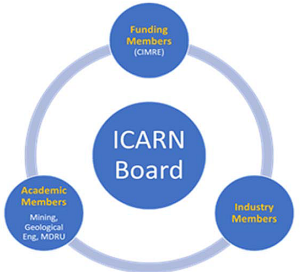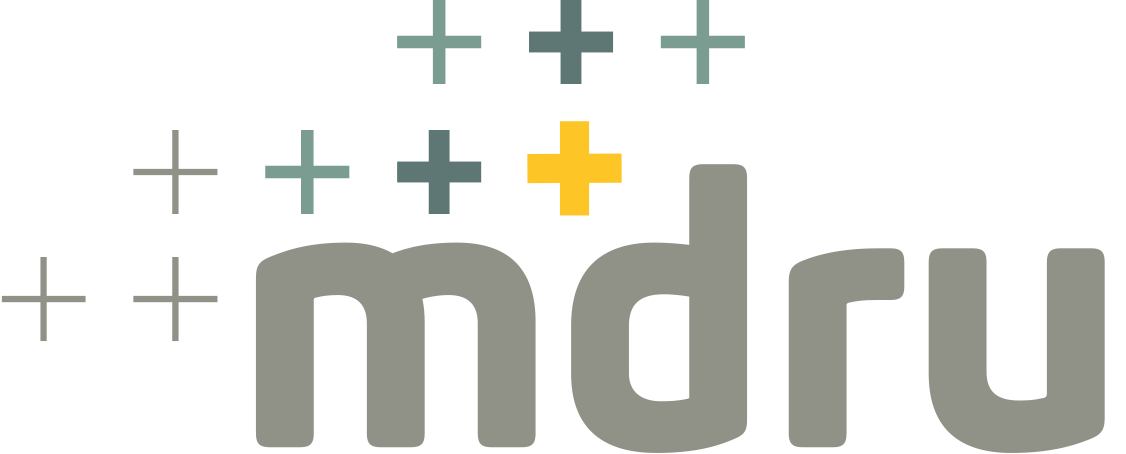Project Information
- Ore Deposit: Kimberlite, Porphyry
- Commodity: Copper, Diamond, Gold
- Location: Global, currently Indonesia, Australia, Canada
- Project Status: Active
- Start Date: January 2020
- End Date: open
The University of British Columbia, in support with the Head of Mining Engineering, the Head of Earth, Ocean and Atmospheric Science, the Director of Geological Engineering, and the Director of the Mineral Deposit Research Unit (MDRU), are pleased to announce the formation of the International Caving Research Network (ICaRN). Building on momentum from recent industry-sponsored university research, ICaRN will consist of a multi‐disciplinary group from industry and academia, covering the fields of operations, geology, cave mining, geomechanics, and mineral processing. The objective of ICaRN is to leverage value from multi‐disciplinary research to address key knowledge gaps identified by industry by focusing on six main research areas as follows:
1. Geometallurgy/Orebody Knowledge
2. Grade Management
3. Cave Mine Design
4. Integrated Cave‐to‐Mill
5. New Measurement Technologies
6. Hazard Management
Background
Recent data from the International Copper Study Group (ICSG 2017) show that the global demand and production of copper has more than tripled in the last 50 years. This has been in response to increasing populations and economic growth. Demand is expected to increase further in response to the shift towards electric cars and renewable energy sources, which are heavily reliant on copper. However, the ICSG (2017) also identified several constraints on copper supply, which includes declining ore grades, especially as near surface resources are exhausted and mining is pushed deeper. Forecasts indicate that there will be an increase in copper production from underground operations over the next decades as available resources trend deeper. Already the industry is seeing the transition of several large open pits to underground operations to access deeper resources, with mass mining methods such as block and panel caving being favoured due to the tonnages and economics achievable.
With the need to mine deeper, comes several key challenges that expose limitations in existing mining practices and engineering design tools. Moss (2014) argues that a step change is required for the industry to transition to cave mining at the scale required to achieve economies similar to open pit mining, while also managing the risks and increased energy demands resulting from mining deeper. These include: i) more limited geological data due to greater drilling depths and therefore greater geological uncertainty, ii) encountering higher stresses and greater risk of ground failure resulting in increasing safety hazards and costly interruptions to production, and iii) increased energy demands for material handling and processing. Compounding these project risks is that approximately 70 percent of capital costs are consumed before any revenue is generated (Oancea, 2013).
Thus, caving has a very different risk profile than open pit mining and other underground methods with one of the critical areas being Run of Mill (ROM) grades that are delivered to the mill. Though caving can match pits in terms of operating cost per ton, it suffers from limited grade selectivity with ROM grades trending toward the orebody average due to consequences of mixing in cave columns. Research and subsequent operational trials have demonstrated that bulk sorting can manage this lack of selectivity by “pre‐concentrating” the ROM ore, providing the mill with a more consistent and higher grade feed. Their implementation holds significant potential to extend the life of existing open‐pit operations by providing an economic means to access ore located at depths beyond the practical limits of open‐pit mining.
Research
Research will focus on the concept that value can be realized by an integrated approach to orebody knowledge, mine design and operation where the objective is to reliably provide consistent feed (tons and grade) to the flotation circuit. This is done in three stages. The first is better characterization of the material reporting to the drawpoints. Secondly, measurement of the variation in metal content that is delivered from drawpoints through the use of scanners and sensors at various points in the ore flow system. Finally, bulk sorting systems offer flexibility and control by allowing classification of waste, low grade and mill grade streams in real time. The potential for bulk sorting is dependent on the heterogeneity of the ore and the ability of sensors to detect the heterogeneity.
The proposed collaborative caving research network will reduce the risks associated with caving, and more broadly, mass mining. Specific areas of research will focus on:
1. Geometallurgy and Orebody Knowledge to improve characterization of the rock mass properties for more accurate fragmentation prediction and draw control, with opportunities to cross‐link to ore grade and recovery.
2. Grade Management through sensor‐based sorting to evaluate bulk and particle sorting systems for integration with underground mobile equipment and material handling systems.
3. Cave Mine Design to facilitate effective and efficient underground sorting systems and improved footprint reliability.
4. Cave‐to‐Mill involving the integration of processes to enhance mine and mill performance and bulk sorting to provide selectivity options and reliable feed to the process plant.
5. New Measurement Technologies through implementation of advanced instrumentation to monitor drawpoint muck grade, cave loads, and excavation displacements and pillar bulking.
6. Hazard Management Strategies to more effectively monitor, forecast and mitigate undercut and extraction‐level hazards such as rock bursting and mud rush, to improve safety and production reliability by reducing interruptions.
The overall objective of the research will be to enhance value of mine projects/operations. The research is substantially focused on revenue generation (increasing ROM grade to mill, increased mill throughputs etc.). Though there are number of ways in which value can be measured, the most common in use within the industry is Net Present Value (NPV). All research projects will therefore be required to demonstrate their potential for enhancing NPV as part of the selection process.
Governance
Participation is through membership in the ICaRN consortium and is open to mining companies that are actively engaged from early stage orebody definition through project design and planning to mine operations. Members will have access to the outcomes of the various research projects and will have the opportunity of strongly influencing the selection of specific projects within the overall objectives of the cave to mill concept. The overall structure of ICaRN is illustrated below:

Governance will be a key tenet of the overall program and is in place to ensure that:
1. The broad research objectives will be aligned with industry goals and has value propositions that are acceptable to the Board.
2. Projects are selected and appropriately funded based on the priorities as determined by the ICaRN industry and academic members.
3. Budget and schedule commitments are met (within the constraints of applied research). Outcomes are delivered at appropriate stages throughout the overall research schedule with the intent of enhancing industry engagement.
As ICaRN grows, it will develop additional research projects and resources , with the common overall objective of enhancing value and safety of mine projects/operations
Projects and Funding
The project is active now with several projects underway, based at Grasberg (Indonesia) with the support of Freeport, and at Cadia (Australia) with the support of Newcrest. These projects have some management support from CIMRE and have leveraged additional financial support for students from Mitacs.
• Mahir Cetin, PhD Student (w. Bern Klein) – Tracking Grades and Heterogeneity from Cave to Concentrator, Grade control and bulk sorting
• Will Futcher, MASc Student (w. Bern Klein) – Bulk Sorting – maintaining metal production (with plant interruptions, declining grades); Effect of Preconditioning on Mill Throughout.
• Pils Li, PDF (w. Bern Klein) – Bulk Sorting (Fractal Analysis, Sorting Cutoff Grade); Geometallurgical orebody modelling; Advanced sorting classification algorithms
• Tsolmon, PhD Student (w Davide Elmo) – Preconditioning and Fragmentation; Calibration of PCBC
• Russel (Zhen) Li, PhD Student (w Allan Moss) – Lessons Learned
ICaRN Contacts
For more information about ICaRN, please see contact list below:
- Mr. Allan Moss: Chairman ICaRN – amoss@fmi.com
- Prof. Bern Klein: Mining Engineering ‐ bklein@mining.ubc.ca
- Prof. Erik Eberhardt: Geological Engineering – erik@eoas.ubc.ca
- Dr. Craig Hart: MDRU – chart@eoas.ubc.ca
- Assist. Prof. Scott McDougall: Geological Engineering – smcdouga@eoas.ubc.ca
- Assoc. Prof. Davide Elmo: Mining Engineering – delmo@mining.ubc.ca
UBC Faculty Support
ICaRN is supported by the UBC Faculty of Science and the UBC Faculty of Applied Science.
Media
Deep Learning – International Caving Research Network looks for solutions to deep mining problems and challenges
CIM Magazine March 02, 2020.



